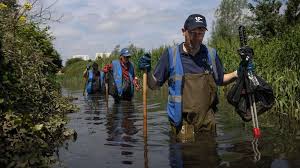UK rivers contain ‘cocktail of chemicals and stimulants’ endangering aquatic life

The UK’s rivers contain a cocktail of chemicals and stimulants including caffeine, antidepressants and painkillers from water company sewage releases, polluting freshwaters at levels which can pose a risk to aquatic life, testing has found.
Results from three days of testing in rivers by 4,531 volunteers for the environmental research group Earthwatch showed that, in addition to the chemical mix in rivers, 61% of fresh waters in the UK were in a poor state because of high levels of the nutrients phosphate and nitrate, the source of which is sewage effluent and agricultural runoff. England had the worst level of poor water quality in rivers, with 67% of freshwater samples showing high levels of nitrate and phosphate.
“Our rivers have been historically stressed by farming and are being pushed to the brink by outdated and inadequate sewage treatment works,” Earthwatch said.
Earthwatch volunteers tested rivers over three days in September, gathering 2,338 datasets which were tested for high levels of phosphates and nitrates. Ninety-one samples were sent for further testing for the presence of chemicals by Imperial College London. This testing, which is continuing, shows rivers are being subjected to toxic pollutants including nicotine, caffeine, antidepressants, antibiotics and painkillers such as tramadol and diclofenac. The main source of these pollutants is sewage from water company treatment works, said Sasha Woods, head of policy at Earthwatch.
Woods said the UK’s freshwater ecosystems were in a terrible state and that citizen science data was helping to fill in the gaps in testing to expose the true picture. She said the chemical results were shocking, revealing a failure to adequately deal with sewage.
“Caffeine was present in 100% of samples sent to Imperial,” said Woods. “This is alarming because it shows either that sewage effluent is not being cleaned properly by water companies before being discharged into rivers, or that too much raw sewage is going into rivers, or both of those things.”
Volunteers in what was termed the Great UK WaterBlitz collected the thousands of datasets at geographically spread locations across the UK over three days in September. Measurements of nitrates and phosphates taken by the volunteers within a river sub-basin were based on at least five samples per sub-basin.
Acceptable water quality was found where nitrates were under 1 part per million (ppm), and phosphates under 0.1 ppm, aligning with Environment Agency values. England had the worst water quality, with 67% of rivers deemed unacceptable or poor quality, compared with 43% poor quality in Northern Ireland, 29% in Scotland and 21% in Wales. The Anglian and Thames river basin districts have the worst water quality in the UK, with more than 80% of surveys showing unacceptable nutrient concentrations.
Rivers in West Glamorgan in Wales and Kirkcudbrightshire in Scotland had the best water quality of those measured.
Earthwatch said there was a pressing need for improvements to wastewater treatment processes and reductions in agriculture and urban run off to reduce threats to vulnerable freshwater systems and species.
“The poor state of many waterbodies in the UK is down to a complex and interconnected range of pollution sources: sewage discharge, agriculture and urban runoff,” their report said. The Earthwatch evidence of the poor state of UK rivers comes after data from the Environment Agency showed a dramatic decline in Atlantic salmon stocks in England and Wales. Salmon are an indicator species, and their rapid decline is considered a warning sign that the natural environment is under extreme stress.
Privacy Notice: Newsletters may contain info about charities, online ads, and content funded by outside parties. For more information see our Privacy Policy. We use Google reCaptcha to protect our website and the Google Privacy Policy and Terms of Service apply.
after newsletter promotion
The full analysis of about 300 chemicals will be published in a peer-reviewed journal in 2025. Initial results are already building a more complete picture of chemical in rivers and lakes.
Many of the chemicals found contained concentrations considered to pose risks to water creatures:
Of the 91 samples already analysed, 100% contained caffeine, with levels in 80% of these samples presenting some risk to aquatic life, said Woods.
Nicotine was found in 25% of samples, with concentrations that present some risk to aquatic life found in 7% of samples. The antidepressant venlafaxine was found in 30% of samples analysed, with 13% of samples containing levels that posed a risk to aquatic life.
The antibiotic trimethoprim was found in 10% of samples, all at concentrations that posed some level of risk to aquatic life.
Diclofenac, a non-steroidal anti-inflammatory drug, was in 11 % of samples, all of which showed some level of risk.
In 5% of samples, the fungicide tebuconazole was present as a result of agricultural runoff.
The neonicotinoid acetamiprid, used for pet flea treatment, was present in 19% of samples, all showing some level of risk to aquatic life.
Earthwatch said the results showed the strong contribution that citizen science played in presenting a clearer picture of the health of rivers.
James Finnegan, from the Environment Agency, said: “The Environment Agency recognises the benefit of citizen science. We see it complimenting Environment Agency monitoring to strengthen our understanding of whole-catchment systems.”





